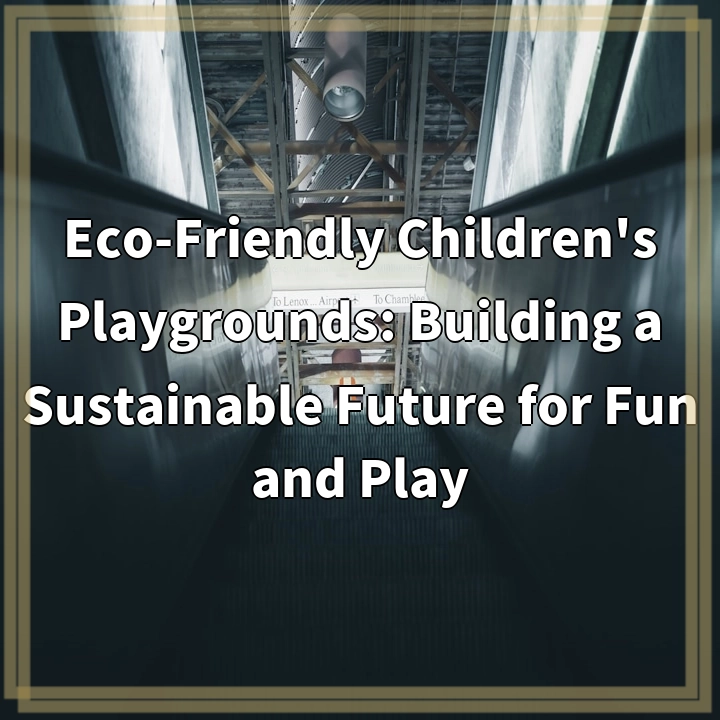Physical Address
304 North Cardinal St.
Dorchester Center, MA 02124
Physical Address
304 North Cardinal St.
Dorchester Center, MA 02124

Eco-friendly children’s playgrounds are designed and built with sustainability in mind. They prioritize the use of environmentally friendly materials, energy-efficient technology, and sustainable practices to create play spaces that are safe and conducive to a child’s development while minimizing their impact on the environment.
Despite the many benefits of traditional playgrounds, they often contribute to various environmental and health issues. Some of the real-world problems associated with conventional playgrounds include:
Many urban areas lack sufficient green spaces for children to play and connect with nature. This deficit of natural environments impacts their mental and physical well-being. By incorporating eco-friendly playgrounds, we can increase the availability of green spaces and promote a deeper connection with the environment.
Conventional playgrounds typically utilize materials that contain toxins and hazardous substances, such as chemically treated wood, PVC, and lead-based paints. Children exposed to these substances are at risk of developing health issues. Eco-friendly playgrounds prioritize using non-toxic and sustainable materials, ensuring a safer environment for children.
Traditional playgrounds often rely on energy-intensive features such as electric-powered rides, lights, and water features. This heavy energy consumption contributes to greenhouse gas emissions and increases the ecological footprint. Eco-friendly playgrounds aim to minimize energy consumption by utilizing renewable energy sources, efficient lighting systems, and low-energy play equipment.
Many conventional playgrounds have water features that consume significant amounts of water, leading to wastage and potential strain on local water resources. Eco-friendly playgrounds implement water-efficient designs, utilizing technologies such as rainwater harvesting and water recycling to minimize water waste.
Traditional playgrounds often lack inclusive design features, making it challenging for children with disabilities or mobility issues to fully engage in play. Eco-friendly playgrounds prioritize accessibility by incorporating ramps, sensory play equipment, and inclusive designs to ensure that every child can enjoy and benefit from their play experience.
Eco-friendly children’s playgrounds present a sustainable solution to these real-world problems. By creating play spaces that are environmentally conscious, we can ensure a healthier, safer, and more inclusive future for our children while nurturing their love for nature and promoting sustainable values.
Addressing the real-world problems associated with traditional playgrounds requires implementing sustainable solutions in the design and construction of eco-friendly children’s playgrounds:
Eco-friendly playgrounds prioritize the incorporation of green spaces, ensuring children have access to natural environments. This includes integrating elements such as trees, plants, and natural materials to create a more immersive and nature-filled play experience.
Eco-friendly playgrounds opt for non-toxic and sustainable materials, eliminating the use of hazardous substances. This ensures a safer and healthier play environment for children while reducing the risk of exposure to harmful toxins.
Eco-friendly playgrounds focus on reducing energy consumption by utilizing energy-efficient technologies. This includes utilizing renewable energy sources like solar power, implementing LED lighting systems, and incorporating low-energy play equipment.
Eco-friendly playgrounds employ water-efficient designs and technologies to minimize water consumption. This includes rainwater harvesting systems, water recycling, and incorporating low-flow water features.
Eco-friendly playgrounds prioritize inclusive designs to ensure that all children, regardless of their abilities, can fully participate in play activities. This includes incorporating wheelchair-accessible ramps, sensory play equipment, and inclusive play structures.
By implementing these solutions, eco-friendly children’s playgrounds create a positive impact on both the environment and the well-being of young children. They promote a love for nature, sustainable values, and a healthier future for generations to come.
Eco-Friendly Children’s Playgrounds
If you’re wondering where the article came from!
#